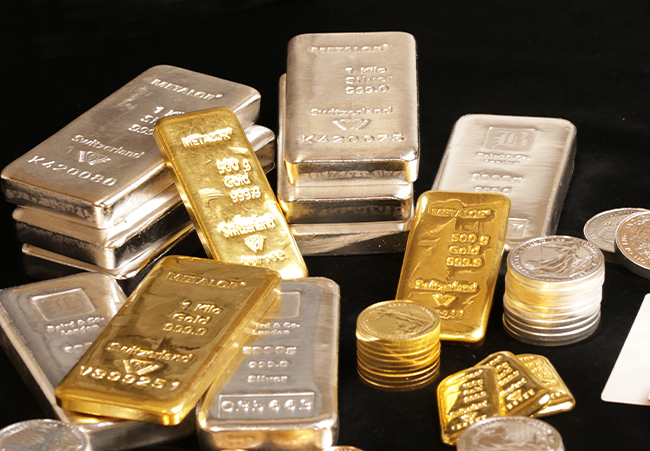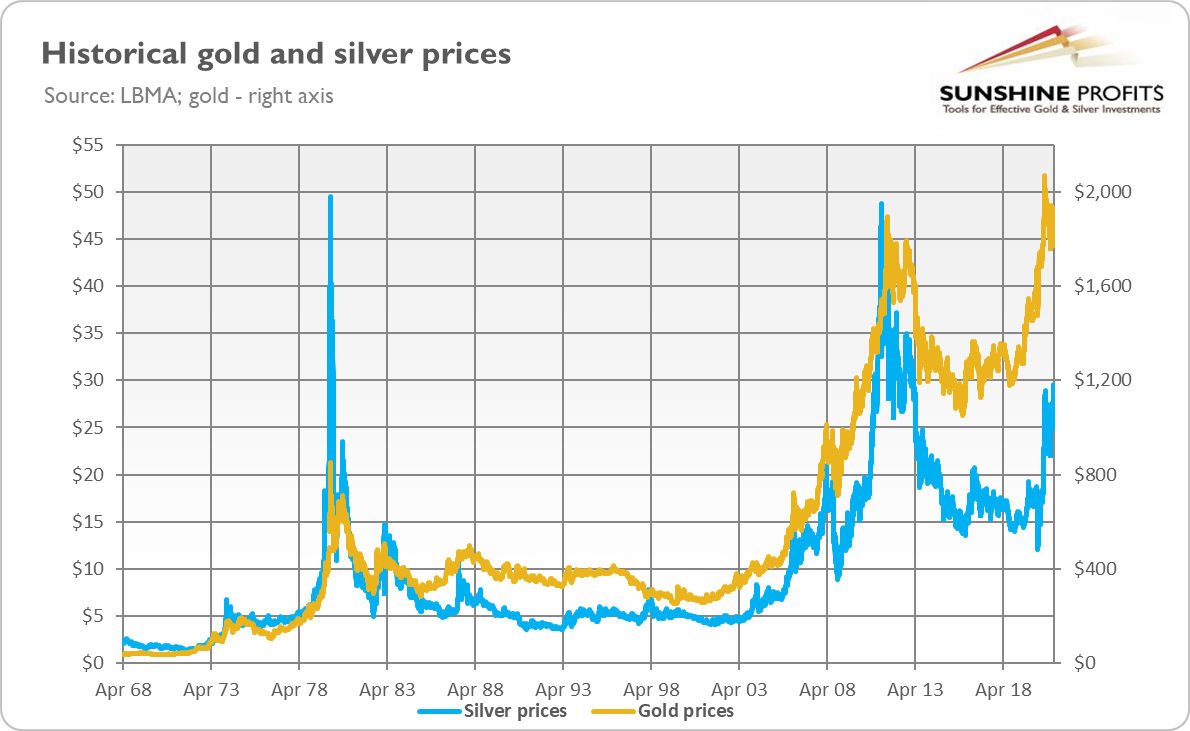A Glittering Historical past: Deciphering The Worth Charts Of Gold And Silver
A Glittering Historical past: Deciphering the Worth Charts of Gold and Silver
Associated Articles: A Glittering Historical past: Deciphering the Worth Charts of Gold and Silver
Introduction
With enthusiasm, let’s navigate by the intriguing matter associated to A Glittering Historical past: Deciphering the Worth Charts of Gold and Silver. Let’s weave attention-grabbing data and provide contemporary views to the readers.
Desk of Content material
A Glittering Historical past: Deciphering the Worth Charts of Gold and Silver

Gold and silver, shimmering symbols of wealth and prosperity all through historical past, have captivated buyers and societies for millennia. Their costs, nonetheless, are removed from static, fluctuating wildly based mostly on a posh interaction of financial elements, geopolitical occasions, and investor sentiment. Analyzing their historic worth charts reveals fascinating patterns and affords useful insights into the dynamics of those treasured metals markets. This text delves into the value historical past of gold and silver, analyzing key durations of development and decline, and exploring the elements driving these actions.
A Glimpse into the Previous: Pre-Fashionable Period
Earlier than the arrival of available worth information, the worth of gold and silver was largely decided by their relative shortage and their use as mediums of trade. Historic civilizations just like the Egyptians, Greeks, and Romans established financial programs based mostly on these metals, with their worth fluctuating based mostly on elements like conquest, commerce routes, and mining yields. Intervals of political stability and financial prosperity usually noticed comparatively secure costs, whereas wars and societal upheavals led to volatility. Whereas exact worth charts from these eras are unavailable, historic data and archaeological findings provide glimpses into the relative worth of those metals in comparison with different commodities and their affect on financial programs.
The Fashionable Period: Knowledge and Dynamics
The fashionable period, marked by the institution of organized exchanges and the gathering of dependable worth information, permits for a extra detailed evaluation of gold and silver worth actions. Whereas exact every day information from the early twentieth century is perhaps incomplete, available charts from the latter half of the twentieth century and the twenty first century present a wealthy supply of knowledge.
Gold: A Protected Haven Asset
Gold’s worth historical past is usually characterised by its function as a safe-haven asset. In periods of financial uncertainty, geopolitical instability, or inflation, buyers flock to gold as a retailer of worth, driving its worth upward. The next are some key durations illustrating this:
-
The Bretton Woods Period (1944-1971): Below the Bretton Woods system, the US greenback was pegged to gold, offering worth stability. Nonetheless, the system’s eventual collapse in 1971, pushed by growing US debt and inflation, unleashed gold’s worth, resulting in a major surge.
-
The Nineteen Seventies Inflationary Interval: The oil disaster and rampant inflation of the Nineteen Seventies considerably boosted gold’s worth, as buyers sought refuge from depreciating currencies. This era noticed gold costs climb dramatically, demonstrating its effectiveness as an inflation hedge.
-
The 2008 Monetary Disaster: The worldwide monetary disaster of 2008 triggered one other huge surge in gold costs, as buyers misplaced confidence in conventional monetary belongings and sought the safety of gold. This highlighted gold’s function as a hedge towards systemic danger.
-
Latest Traits: Gold costs have seen important fluctuations in recent times, influenced by elements resembling rate of interest hikes by central banks, US greenback energy, and world financial development. Geopolitical tensions and uncertainty proceed to behave as drivers of gold’s worth.
Silver: Industrial Steel and Funding Asset
Silver’s worth historical past is extra advanced than gold’s, because it serves each as an funding asset and an important industrial metallic. Its worth is influenced not solely by investor demand but additionally by industrial consumption, making its worth extra risky than gold’s.
-
Industrial Demand: Silver’s widespread use in electronics, photo voltaic panels, and different industrial functions considerably impacts its worth. Elevated industrial demand usually results in worth will increase, whereas a slowdown in industrial exercise can depress costs.
-
Funding Demand: Just like gold, silver additionally advantages from investor demand in periods of financial uncertainty. Nonetheless, its industrial makes use of make it extra inclined to produce and demand shocks associated to industrial manufacturing.
-
Silver-Gold Ratio: The silver-gold ratio, which represents the variety of ounces of silver wanted to purchase one ounce of gold, fluctuates considerably. Traditionally, the ratio has been a lot increased than 1:1, indicating that silver is mostly cheaper than gold. Nonetheless, this ratio has diverse significantly all through historical past, reflecting the relative provide and demand dynamics of each metals.
-
Latest Traits: Like gold, silver’s worth has seen appreciable volatility in recent times, influenced by industrial demand, investor sentiment, and macroeconomic elements. The interaction between these elements creates a dynamic and sometimes unpredictable worth motion.
Analyzing the Charts: Figuring out Patterns and Traits
Analyzing historic worth charts of gold and silver reveals a number of key patterns:
-
Lengthy-Time period Upward Development: Each gold and silver have typically exhibited a long-term upward pattern over the previous a number of many years, reflecting their function as inflation hedges and shops of worth.
-
Brief-Time period Volatility: Regardless of the long-term upward pattern, each metals expertise important short-term volatility, influenced by varied elements talked about above.
-
Correlation and Divergence: Whereas gold and silver costs usually transfer in tandem, additionally they expertise durations of divergence, reflecting the differing influences on their respective markets.
-
Impression of Macroeconomic Elements: Rates of interest, inflation, forex fluctuations, and financial development considerably influence each gold and silver costs.
-
Geopolitical Occasions: Geopolitical instability and uncertainty usually result in elevated demand for each metals, driving their costs upward.
Conclusion: Navigating the Way forward for Gold and Silver Costs
Predicting the long run costs of gold and silver stays a difficult job. The interaction of quite a few financial, geopolitical, and industrial elements creates a posh and dynamic market. Nonetheless, by fastidiously finding out historic worth charts and understanding the underlying drivers of worth actions, buyers can acquire useful insights and make knowledgeable selections. The long-term outlook for each metals stays constructive, given their roles as safe-haven belongings and industrial commodities. Nonetheless, buyers needs to be ready for short-term volatility and the potential for important worth fluctuations. Diversification inside a well-defined funding technique, coupled with a radical understanding of market dynamics, is essential for navigating the ever-evolving world of treasured metals funding. Steady monitoring of macroeconomic indicators, geopolitical occasions, and industrial developments is important for staying knowledgeable and making sound funding selections on this dynamic and engaging market.
:max_bytes(150000):strip_icc()/GOLD_2023-05-17_09-51-04-aea62500f1a249748eb923dbc1b6993b.png)







Closure
Thus, we hope this text has offered useful insights into A Glittering Historical past: Deciphering the Worth Charts of Gold and Silver. We thanks for taking the time to learn this text. See you in our subsequent article!